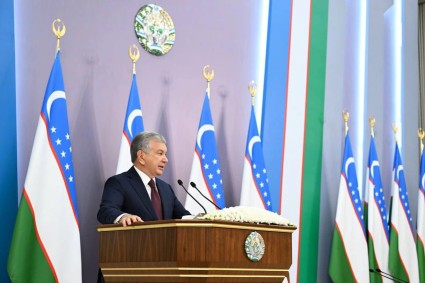The economies of Central Asia demonstrated strong growth in the first half of 2023, bolstered by a resumption of international trade and tourism, as well as high levels of migration and remittances from Russia, according to the European Bank for Reconstruction and Development’s (EBRD) latest Regional Economic Prospects (REP) report, published today.
According to the Bank, GDP growth in the region is likely to remain robust at 5.7 per cent in 2023 and 5.9 per cent in 2024.
The recent bout of growth – driven by government spending, China’s reopening, intermediated trade with Russia, as well as remittances, tourism and business relocation from Russia – is likely to continue. The REP notes, however, that higher borrowing costs may affect the scale and appetite for investment in the region. At the same time, recent water and energy supply disruptions may prompt long-overdue tariff reforms, as well as better resource management.
The economy of Kazakhstan is set to grow by 5.0 per cent in both 2023 and 2024, though with some uncertainty arising from oil prices. The country has seen significant expansion in sectors such as retail and wholesale trade and construction. There has also been a pick-up in public and private investment in infrastructure, transport and warehousing, reflecting Almaty’s growing role as a distribution hub serving Central Asian markets. The ongoing war on Ukraine, however, may have a negative impact on the operation of the Caspian Pipeline Consortium terminal on the Black Sea, potentially disrupting Kazakhstan’s oil exports.
The GDP of the Kyrgyz Republic is expected to grow 4.6 per cent in 2023 and 7 per cent in 2024. The country’s economic growth slowed to 2.9 per cent year on year in the first seven months of 2023 due to a contraction in metals output (mostly gold) and the agricultural sector. At the same time, the domestic textiles sector boomed thanks to strong external demand. There was also significant expansion in tourism, triggering growth in food production, hospitality, and retail and wholesale trade. The REP warns Kyrgyzstan’s outlook could be worsened by energy and water shortages as well as secondary sanctions related to Kyrgyzstan’s outsized role in intermediated trade with Russia.
Mongolia’s economy is likely to grow by 7.2 per cent in 2023 and 7.5 per cent in 2024, driven by China’s demand for the country’s commodities, the launch of new rail lines connecting the Tavan Tolgoi coal deposits with China, and the start of underground production at the Oyu Tolgoi mine. The tourism sector has recovered fully and is helping to improve performance of the hospitality and cashmere industries. Stronger growth in exports, mining and tourism may strengthen the outlook; the tightening of global credit conditions and a slowdown in China are the main downside risks.
The economy of Tajikistan is expected to post strong growth of 7.5 per cent in both 2023 and 2024. Stronger regional cooperation, public investment (particularly in water and energy infrastructure), the inflow of remittances from Russia and strong performance of the manufacturing and agricultural sectors are key influencing factors. A slowdown in Chinese growth and potential conflicts over transboundary water resources may negatively affect the outlook.
Uzbekistan’s GDP growth is set to reach 6.5 per cent in both 2023 and 2024, fuelled by strong domestic demand, an increase in nominal wages and credit growth. Sectors such as retail trade, construction, services and agriculture perform particularly well. Well-managed initial public offerings (IPOs) and privatisations may strengthen the outlook. Further reductions in remittances (particularly from Russia), aging infrastructure and water supply issues are among the factors that may hamper growth.
EBRD regions’ overall forecast
Growth in the EBRD regions is expected to slow to 2.4 per cent in 2023 from 3.3 in 2022. In 2024, as inflation continues to ease, growth is expected to pick up to 3.2 per cent. The figures reflect an upward revision of 0.2 percentage point to May’s forecast for 2023 and a downward revision of 0.2 per cent to the forecast for the following year.
EBRD Chief Economist Beata Javorcik said: “Our economists see a diverging pattern of growth among the EBRD regions. The robust growth of the economies of Central Asia and the weaker performance of those in central Europe and the Baltic states reflect the different consequences of energy prices, inflation and shifting patterns of trade.”
Significant developments
There are a number of trends influencing the latest economic forecast.
Gas consumption in emerging Europe fell by more than 20 per cent in the winter of 2022-23 as the reduced supply of gas from Russia resulted in much higher energy prices. Oil and gas prices, though back to below levels preceding the war on Ukraine, continue to weigh on the region’s growth.
European industry has shifted away from gas-intensive sectors, such as construction materials, chemicals, basic metals and paper, while increasing production in less carbon-intensive sectors, such as electrical equipment, car manufacturing and pharmaceuticals.
In Poland, for example, basic metals production declined by 18 per cent year on year, while electrical equipment production increased by 21 per cent year on year.
Overall, total industrial output in Europe has been lower than expected, contributing to slower economic growth. Nevertheless, the labour market has remained resilient, with companies retaining jobs despite large changes in the structure of output. And, amid high inflation, nominal wages have increased rapidly in many economies. In some cases, such as in the Baltic states and Hungary, wage increases have outpaced productivity growth, reducing competitiveness.
In contrast, growth in the economies of Central Asia and certain countries in the Caucasus remained strong year on year in 2022 and the first half of 2023. This was due to intermediated trade to and from Russia, as well as high levels of migration to and subsequent remittances from Russia, which underpinned robust real wage growth.
Regional projections
In central Europe and the Baltic states, where high costs for food and energy tightened households’ budgets and small and medium-sized enterprises’ access to finance for investment has been reduced, growth is expected to average 0.5 per cent in 2023, down from 3.9 per cent in 2022, and rise to 2.5 per cent in 2024.
A weaker external environment and the impact of inflation in EBRD economies in the south-eastern European Union is expected to lead to growth of 2 per cent in 2023 and a pick-up to 2.8 per cent in 2024.
In the Western Balkans, the effect of weakening trade with Eurozone partners at the beginning of 2023 was partly offset by the strong performance of the tourism sector in the region’s service-based economies. Gross domestic product (GDP) is projected to grow by 2 per cent in 2023 and reach 3.4 per cent in 2024.
In Eastern Europe and the Caucasus, economies have been adjusting to the extreme shock caused by the war on Ukraine. The forecast sees GDP growth of 1.9 per cent in 2023 and a rise to 3.1 per cent in 2024.
In Ukraine, GDP growth of 1 per cent is expected for 2023, reflecting a sharp year-on-year contraction in the first quarter. This is likely to be followed by an increase of 3 per cent in 2024.
Growth in Türkiye is forecast at 3.5 per cent in 2023 and 3 per cent in 2024. The 1 percentage-point upward revision from the previous forecast reflects pre-election fiscal stimulus, though growth is expected to slow in the second half of the year.
Output in the southern and eastern Mediterranean region* is expected to grow by 3.7 per cent in 2023 and 3.9 per cent in 2024, with the downward revisions from the previous forecasts reflecting delays to structural reforms and increased fiscal and external vulnerabilities.













